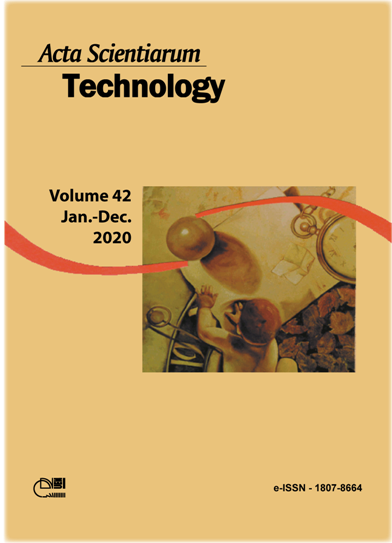Preparation of mesoporous activated carbon from defective coffee beans for adsorption of fresh whey proteins
DOI:
https://doi.org/10.4025/actascitechnol.v42i1.45914Palavras-chave:
agroindustrial waste; adsorbent; isotherms; Raman spectroscopy; whey proteinsResumo
Whey protein has high biological value and functional properties. Therefore, it is necessary to develop methods to recover this valuable protein and minimize the environmental impacts. Adsorptive processes using alternative adsorbents from agroindustrial waste increase the number of alternatives for adequate final disposal of the waste and add value. The aim of this study was to develop a mesoporous activated carbon (AC) from defective coffee beans (DCB) for the adsorption of fresh whey protein. The morphological structure of the adsorbent produced was characterized, and both Raman spectroscopy, FTIR and thermal analyses were performed; and the effect of pH on the adsorption capacity (q, mg g-1) was evaluated. The characterization showed that: the AC exhibited a porous size between 33 and 43 Å, corresponding to mesoporous materials; the crystallite size (La) of AC was estimated at 9.31 ± 0.14 nm; the highest adsorption capacity value (239.1781 mg g-1) was achieved at pH 2.5 and 25ºC; and the point of zero charge of the adsorbent was at pH 2.0. The pseudo first-order model fit best to the experimental results (R2 > 0.99) of whey protein adsorption onto activated carbon, and the Langmuir model was the most appropriate to represent the experimental data, with a maximum adsorption capacity of 378.4380 mg g-1, demonstrating the potential of AC obtained from DCB to adsorb fresh whey protein.
Downloads
Downloads
Publicado
Como Citar
Edição
Seção
Licença
DECLARAÇíO DE ORIGINALIDADE E DIREITOS AUTORAIS
Declaro que o presente artigo é original, não tendo sido submetido í publicação em qualquer outro periódico nacional ou internacional, quer seja em parte ou em sua totalidade.
Os direitos autorais pertencem exclusivamente aos autores. Os direitos de licenciamento utilizados pelo periódico é a licença Creative Commons Attribution 4.0 (CC BY 4.0): são permitidos o compartilhamento (cópia e distribuição do material em qualqer meio ou formato) e adaptação (remix, transformação e criação de material a partir do conteúdo assim licenciado para quaisquer fins, inclusive comerciais.
Recomenda-se a leitura desse link para maiores informações sobre o tema: fornecimento de créditos e referências de forma correta, entre outros detalhes cruciais para uso adequado do material licenciado.















